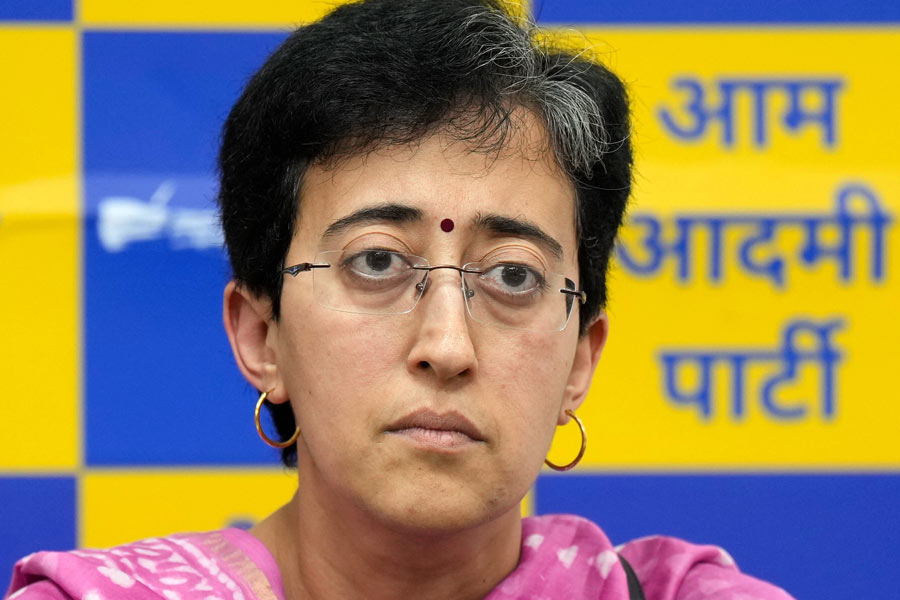A couple in bathing gear is having a jolly good outdoor romp, padding about in flippers, playing games. Nothing unusual about that except that it isn’t summer. The bare land, cloaked in snow, makes the viewer go brrr at the very sight, but the scantily-clad duo are unconcerned, no flinching against the cold. Then the scene changes to a desolate landscape with humps of stone or coal chips. The same pair trudge about scooping up the chips and loading them into waiting buckets that are carried to an underground cave and emptied into two giant metal containers with snouts. The two then lie down in a bed while the snouts shoot coal chips at them. Slowly, unnervingly, the chips pile up, covering them as their chests heave underneath...
Not surprisingly, Nezaket Ekici, the Turkish-German woman in the video, is inspired by Marina Abramovic to test, along with her collaborator, the Israeli artist, Shahar Marcus, the elasticity of the human body, pushing it to physio-psychological extremes, setting on edge the nerves of viewers who would have, if this were a live performance, surely screamed, Stop! This little gem of a video, placed in a niche next to a corner reserved for Louise Bourgeois originals, was part of Birla Academy’s 54th Annual which ended in February. It came from the museum’s own collection which constituted the entire non-competitive section this year.
Apart from a host of late-19th century and early 20th century artists like Dhurandhar and S.D. Satwalekar, Almelkar and Mali, Parandekar and Gondhalekar, there was a veritable who’s who of Indian modernism: Raza (picture, left), Ara, Husain, Hebbar, Padamsee, Himmat Shah, Gogi Saroj Pal, Krishna Reddy et al. A breathless procession covering several generations. The period flavour was refreshing, but an opulent multi-star show of this scale can be fatiguing without curatorial coherence.

The Judgemental Lines by Abhijit Das. Birla Academy
In the competitive section, the artist who drew notice right away was Abhijit Das. The Judgmental Lines (picture, right) seemed to script a geological diary by crumpling the skin of the earth, as it were, into long, dense, horizontal rucks, heaving from some subterranean churning. Arindam Adhikary’s graphite pencil, on the other hand, was a subtle explorer of the delicate plasticity of skin, of sensuous surfaces that hint at shifting volumes of dimpled, flaccid flesh underneath, of undulating soil and tactile drapes with creases, folds and crevices. The geological narrative was made darker by Prabir Kumar’s watercolour stippled in charcoal that turned The Smoky Land into a brooding and bristly ground.
Chandra Nath Saha’s irony in re-interpreting the motto of Atmanirbhar in terms of migrants depending on their own feet to cover long distances remains sharply relevant. Another political comment came from Bivas Paul, whose Kashmiri Carpet, painted in acrylic in painstaking detail, was partially burnt, black smoke billowing forth. Monojit Samanta assembled a loquacious cityscape with leather, cloth and acrylic. But to Ishita Adhikary and Subrata Saha a thoughtful mix of rust browns and smoky blacks, bleak horizons and lifeless, condemned figures were a recipe for a dystopian endgame.
If Nilmoni Raha’s sculpture of a caged heart carried multiple resonances, Anup Mondal’s empathy with farmers saw, in a paper pulp spade, the rib cage of the toiler. Alik Mondal, however, identified his paper pulp rib cage as a sturdy anchor. While there was an elegant brevity in Partha Dey’s environmental message, a poetic contemplation marked Rupa Nath’s embroidered hair. Abhijit Sarkar’s photography of a room’s minimalist geometric angles and their play of shadows tiptoed around moments of elusive epiphany. Also noticeable were the deft print-makers, Tushar Sahay and Padma Karmakar. Finally, Anupam Basu’s motif of migration became, in his video, a moving parable both epochal and enduring.










